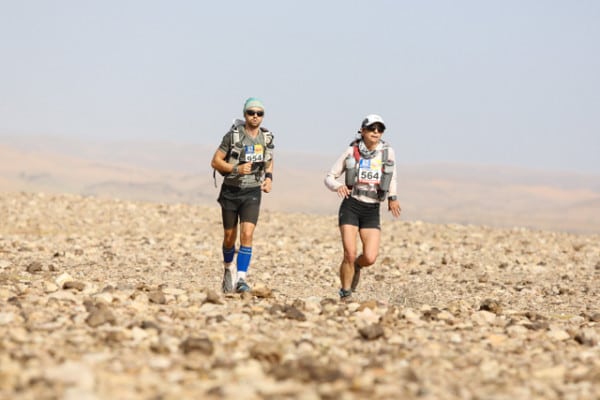From Gina:
In 2005, I was a senior at DeSales University. It was my final cross-country season, and my final year of collegiate racing. I had once again made it to the NCAA DIII Cross-Country Championships and had high hopes of placing top 10. I was racing well, I was strong, and I was hungry. Race day came, and all of that changed when I toed the starting line. Enter: self-doubt and the feeling of being inadequate.
There were 300 or so women running strides to help calm their nerves and prep their bodies. Everyone was wearing butt huggers, crop tops, and gloves (like those little gloves were ever going to keep us warm in late November).
I watched as they ran back and forth and couldn’t get over their size. I felt like a mammoth compared to them. My legs and butt probably doubled most of theirs. My chest was barreled out, and I had hips.
How the hell was I going to be top 10 when I had to carry an extra 20 pounds? These little waifs were going to fly by while I hoofed along at a glacial pace.
I suppose this would be a good time to note that I’m not a ‘tiny’ hater. I realize that some women have a naturally small frame/size. But it was easy to pick out which girls were sick and which were naturally small people. Eating disorders are rampant in college athletics no matter how well someone tries to cover it up. Anyhow, back to my story.
The gun went off and the tinies took the lead. I put my head down and settled into a pace that was comfortable for me. It was a bummer to see them take off so fast, and it messed with my head even more.
About a mile in, I looked up to see a few of the leaders coming back. I was surprised. These light things should be further ahead, at least I thought. I felt fine. In fact, I felt good. Seeing thinner girls coming back to me boosted my adrenaline… and made the self-doubt start to disappear.
Before I knew it, I was passing them. They were spent! Those sinewy muscles were petering out, and my large-and-in-charge thighs were just getting started.
With this bit of mental relief and new thought process, I muscled my way to seventh place. I realized that the weight and the strength I was embarrassed of was actually what I needed to help propel me. The extra pounds were a benefit, not a hindrance. This was one of the moments in my life where I learned to embrace what I was given and use it for all it was worth.
Shortly thereafter, I named my thighs “Pratt & Whitney.” Pratt & Whitney is a company that builds the turbojet engines found on many military and commercial aircraft. “More miles per hour with P&W power” is a Pratt & Whitney slogan.
Though weight and size issues still pop in mind from time to time, this one situation made a huge impression on how I looked at things then and even now.
From Liza:
I can’t quite remember the first time I thought about dropping a few pounds to run faster. It was long after I knew the exact number of calories in a tablespoon of peanut butter, but a good decade or two before I read Matt Fitzgerald’s book, Racing Weight: How to Get Lean For Peak Performance. “Body weight is anathema to the distance runner because the runner must move his or her body against gravity… with every stride. A study by researchers at the University of Georgia… found that a body-weight increase of 5 percent reduced performance by 5 percent in a 12-minute test run.” (p.16) What is the calculation? Every five pounds lost equals 10 seconds per mile faster? Something like that, right? And yes, yes, YES, obviously whether you’re losing muscle or fat is important, and how fast you lose the weight, and what you’re eating and blah, blah, blah. But like every American female, runner and non-runner, I’ve thought that things would be better if I were a pound or five lighter. Truth be told, up until this April, it’d be impossible to tease apart my desire to lose weight to run faster and my desire to lose weight to look a certain way in running clothes. Anybody not have one or two friends who are currently trying to lose weight to run faster or look faster? My weight epiphany didn’t happen during a race like Gina’s. It happened after a race. I ran the Marathon des Sables this year, and the seven-day stage race eradicated my desire to look like a good runner. MdS requires you to carry all of your food for a week, a minimum of 2,000 calories each day. The less food you carry, the lighter your pack, so I carried little more than that race-required minimum. And even at five feet tall and 100-ish pounds, 2,000 calories a day means you’ll lose weight when you’re running 18 to 50 miles a day.

Liza Howard (right) racing Stage 5 of MdS. Photo: Kirsten Kortebein
I’m not sure how much I weighed at the end of MdS, but I remember standing in front of the hotel-room mirror in Morocco thinking, This is not pretty. It was like a switch had been flipped. After 20 years of wanting to have a flat stomach and a thin waist, and evaluating every race photo based on magazine cover-model criteria, I didn’t care anymore. I didn’t want to look lean, or sinewy, or slender. I wanted curves and padding. So I fed myself well until I had some again.



The shift in mindset has been both liberating and frustrating because, as Matt Fitzgerald does say, “body weight is anathema to the distance runner.” And I am currently trying to drop four of the many pounds I gained after MdS to set myself up for success at the Houston Marathon this January and, more importantly, the Bandera 100k the week before. (No, it is not a good idea to PR at a marathon the week after you try to PR at a 100k.) Because regardless of whether or not I’m fixated on how I look in running clothes anymore, I know I’ll have an easier time meeting my running goals if I’m not lugging an extra four pounds around with me for 88 miles. I’ve raced at a lot of different weights through my twenties, thirties, and into my forties–and through two pregnancies–and I do race faster when I weigh 97 to 100 pounds. (I’m five feet tall, and that’s a healthy BMI for a short person.) Still, it’s hard to be disciplined now that the weight loss is tied only to race performance and not attractiveness. Vanity is such a nice motivator. Pam, what say you?
From Pam:
Growing up, my mom lived in old gardening clothes, tennis gear, and sweat suits, and I don’t even think she owned make-up, so a sense of vanity was never deeply instilled in me. As such, I made it to age 34 before I desperately wanted to lose weight or look a different way. That was the year I started competing in more of the “high profile” ultras rather than just at my local races. And as the competition got stiffer, I also noticed it got a lot leaner. I was especially hit hard by this realization at my first Western States in 2010 where I finished 10th. As I stood up front with the other nine ladies at the awards ceremony, I felt like a huge beast. I made the top 10 by the skin of my teeth and felt like if I wanted to place higher, I needed to be thinner. Every Runner’s World article that mentioned 2.5 seconds per pound per mile and other such reasons why getting thinner would make you faster only intensified my obsession with the scale.
By 2012 I got to my lowest ultrarunning weight ever and I had a big PR at the IAU 100k World Championships. But my weight was totally irrelevant when it came to Western States that year. Hypothermia, asthma, and water retention resulted in a 29-hour finish which put me solidly in the bottom 10, not the top 10–those issues didn’t care that I was at my ‘perfect’ race weight. As many people know, that experience really motivated me for 2013 and I not only put in a lot of running miles leading up to Western States, but also a lot of time in the weight room. Ironically, I was actually one pound heavier the year I won than my rookie year when I felt like a fatty. Certainly, that experience helped me realize that performance was linked to a lot more than just a number on the scale and that overall fitness and body composition were much better measures to focus on.
Still, it is very hard for me not to play the comparison game and feel disproportionately large, particularly as more and more of the competition becomes young, nulliparous women. (They have waists and no hip spread–how can I compete?) And I can’t deny that part of getting in shape and feeling fit for me means dropping a little of that extra padding. I am just getting back into the swing of training after a 10-week hiatus, and so like Liza, I am currently trying to lose four pounds. Or maybe five. ;)
From Gina:
There are times for the kind of weight loss that we can benefit from health- and running-performance-wise, but weight loss also has downfalls. Finding your ‘perfect’ race weight comes with trial and error, and in fact, may not exist. Being heavier for one race might be more helpful as compared to being lighter at another, like your examples, Pam. But at the end of the day, I try to keep in mind that my body is shaped a certain way for a reason. I try to embrace what I have, use my strengths, and build on my weaknesses. I think many of us are cognizant of our weight and how it affects performance (and also how we look), but it is important not to get too obsessive about it. I find myself thinking about it more than I’d like, but I also try to use self-talk to help me snap back to reality. Managing your thoughts (though super hard at times) and loving your body is the best advice I can give to help anyone struggling with weight issues.
From Liza:
My journals and training have always been filled with weight-loss goals. It’s embarrassing and tiresome. I hope the switch flipped for me after Marathon des Sables stays flipped. I don’t want to be 50 years old and working out one-pound-a-week weight-loss equations. It makes me sad to even think that might happen. But as useless as vanity is, and as straightforward as staying at a good racing weight should be, the I-Never-Think-About-How-Much-I-Weigh Club is a pretty exclusive (read: nearly nonexistent) one in the Western world. And I kind of expect to get kicked out.
From Pam:
Like many runners, I have a complicated relationship with weight. The rational side of me acknowledges that I have always been at a “normal” weight. But even a couple extra pounds of fat can keep me from being the best and fastest me possible when it comes to running. Getting to ideal body weight is certainly an integral part of getting into race shape, but the weight consciousness often comes with angst and torment over a number on a scale which outside of running would be a perfectly healthy number.
Call for Comments (from Meghan)
- Do you struggle in your relationship with your body weight? How long has the struggle lasted? Did it come about suddenly or has it gradually evolved?
- Have you found that a good racing weight varies among the different kinds of races you do? In other words, are there some races in which you’ve found that a little more or less “meat” helps or hinders? And have you noticed your ideal racing weight to be the same as or different from your healthy body weight in general?
- Have you had experiences like those that Gina, Liza, and Pam shared where you learned that body weight may actually have less to do with running performance than we imagine it might?
- Do you have tips for how to healthfully negotiate your relationship with your body weight?
